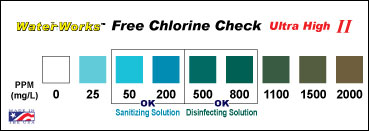In so far as we have read, no cases of Swine Flu have resulted from contaminated drinking water… so why the need for an article about Swine Flu on the Water Testing Blog?
Simple: Viruses like influenza can spread when one person sneezes and coughs their nasal discharge and/or saliva (gross!) lands on a surface that other people touch. The germs will then travel to whatever surfaces those people touch… including their own food, eyes, mouth, etc.
Proper use of sanitizing and disinfecting solutions on a regular basis helps to reduce the number of germs hanging out on surfaces and thus reduces the likelihood of people unknowingly picking up germs and accidentally infecting themselves or others with an illness.
Is chlorine bleach an effective sanitizer/disinfectant?
In most cases, yes. Chlorine bleach works quite well as a germ-killing agent on surfaces and as a matter of fact, many states require childcare facilities to use dilute bleach solutions to clean changing table surfaces and other areas where human waste, a known haven for harmful germs and bacteria, may (inadvertantly) come into contact with surfaces.
As an example, North Carolina requires childcare workers to wipe down a changing area with a disinfecting bleach solution containing between 500 and 800 parts per million free chlorine after they change each child’s diaper. How do they verify that they have the proper concentration of free chlorine in their disinfecting bleach solution? They test with a product such as the Free Chlorine Water Check Ultra High II test strip.
Perhaps ahead of its time, North Carolina REQUIRES childcare facilities to test the free chlorine levels eachtime thet make new batches of disinfecting solutions (for wiping down bathrooms, changing areas) AND sanitizing solutions (for wiping down tables, chairs, doorknobs, toys, etc.). Making sure each solution contains the proper free chlorine levels before use goes a long way to help prevent the spread of germs, bacteria and illnesses.

Sanitizing: 50 – 200ppm Free Chlorine | Disinfecting: 500 – 800ppm Free Chlorine
So what have we learned? Testing the free chlorine levels in cleaning solutions helps to ensure that cleaning efforts accomplish the goal of properly sanitizing and disinfecting surfaces where children and adults can easily pick up germs capable of infecting someone with the common cold, the ‘traditional’ flu, or worse yet, a case of Swine Flu.
Keeping the facilities clean during the flu season is also a consideration, both Shafer and Baeuchle said.
“We regularly sanitize all the toys. After a child has a toy in their mouth, it has to be sanitized,” Shafer said. “We sanitize the tables and chairs on a regular basis in the classrooms.”
Baeuchle said she is asking the school custodians to pay special attention to high frequency areas like water fountains and doorknobs. ( source )
Interested in testing the concentration of chlorine bleach sanitizing and disinfecting solutions? You can pick up a Childcare/Daycare Kit which includes (3) bottles of North Carolina Licensed Child Care Association approved test strips (total of 300 tests!), quarter cup and tablespoon measuring devices (for proper on-site metering of the bleach), and a copy of the procedures North Carolina wants child care workers to follow when mixing their sanitizing and disinfection solutions.





